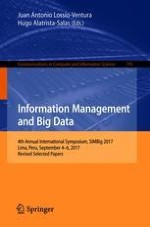2018 | Book
Information Management and Big Data
4th Annual International Symposium, SIMBig 2017, Lima, Peru, September 4-6, 2017, Revised Selected Papers
Editors: Juan Antonio Lossio-Ventura, Hugo Alatrista-Salas
Publisher: Springer International Publishing
Book Series : Communications in Computer and Information Science
